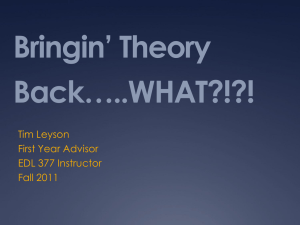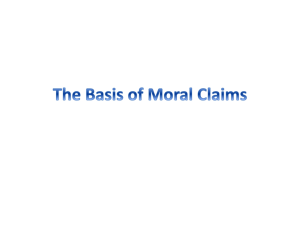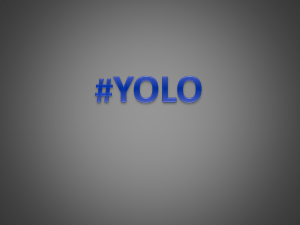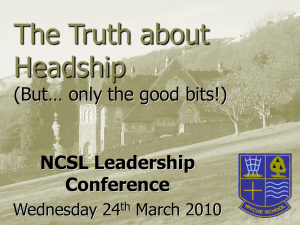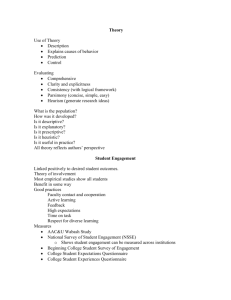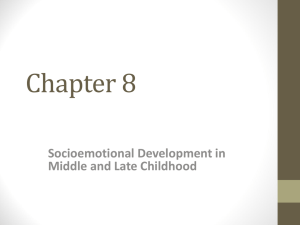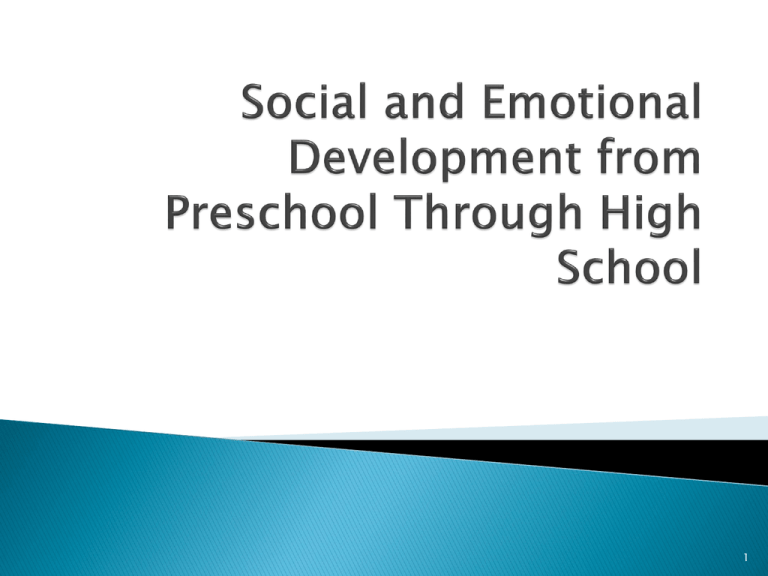
1
2
Urie Bronfenbrenner
Examines the biological make-up of the child
and the effects of environment on
development
Five environmental systems ranging from
◦ direct interactions between child and other social
mediators to
◦ effects of culture and time
3
4
Setting in which an
individual lives
◦ Family, peers, school,
neighborhood
Direct interactions
between child and
microsystems
◦ Bidirectional effects
Child is active
◦ Construct settings
5
Relationships
between
microsystems
◦ Family and peers
◦ Family and
teacher/school
◦ School
6
Experiences in social
settings
◦ Child does not have an active
role
◦ Yet child is influenced via a
microsystem environment
Parent's job: travel, salary,
stress level, hours
Governmental funding: parks,
libraries
7
Attitudes and ideologies
of one’s culture
For example
◦ Judeo-Christian ethic
◦ Democracy
◦ Ethnicity
8
Environmental events that occur over the life
course
◦ Example: disruptive effects of divorce peak one year
after the divorce
◦ Example: sociohistorical conditions
9
Teachers
provide stable relationships for students.
show students that they care about them.
welcome family members into the classroom.
foster relationships with students’ parents and
extended family (e.g., grandparents).
◦ work cooperatively with parents to support
children’s education.
◦ encourage and foster open communication between
parents, students, and the school.
◦
◦
◦
◦
10
Describe the major components of
Bronfenbrenner’s systems: micro-, meso-,
macro-, and chrono-systems.
With a partner discuss specific issues from
each system and how they can affect an
individual child. How can issues from within
each system affect learning in school?
11
Erik Erikson
Psychosocial theory of development
◦ Developmental crisis
◦ Eight stages
12
Crisis
Age Range
Positive Resolution
Trust vs. Mistrust
Infancy
Develop trust that their needs will
be met
Autonomy vs. Shame
and Doubt
Toddlerhood
Make choices and regulate own
behavior, need encouragement and
understanding
Initiative vs. Guilt
Preschool
Complete own activities, need
support and encouragement
Industry vs. Inferiority
School-age
Do productive work, need
recognition
Identity vs. Role
Confusion
Adolescence
Sense of self and how one fits
within society
Intimacy vs. Isolation
Young Adulthood
Develop intimate relationships
Generativity vs.
Stagnation
Middle Adulthood
Concern for helping the next
generation
Integrity vs. Despair
Older Adulthood
Reflect on life’s accomplishments
13
Initiative vs. Guilt
(preschool)
◦ Zest for initiating
activities balanced with
need for restraint
◦ Learn about adult roles
through pretend play
◦ Help kids to make
realistic choices that
don’t conflict with the
needs of others
14
Industry vs. Inferiority
◦ Desire to do productive
work with a growing
sense of confidence
◦ Need to achieve
recognition from
teachers, parents, peers
for production
◦ Encourage kids to make
and do and then praise
15
Identity vs. Role
Confusion
◦ Who am I?
Mixed ideas and feelings
about how fit in society
◦ Organization of drives,
abilities, beliefs, and
history into a structure
of self
Experiment with roles
and activities
16
Children experience success at challenging
tasks
◦ Independent tasks on students’ academic level;
group tasks beyond students’ level
Set realistic goals
◦ Regulate behavior to reach goals
◦ Provide encouragement during the process and
praise work and effort
Provide students with role models
Foster students interests in a variety of
activities and areas
17
Describe the impact of both positive and
negative resolutions for each stage on the
experiences of school age children.
For your intended teaching position, how can
you utilize Erikson’s theory to maximize
learning?
18
Attachment defined
Bowlby and Ainsworth
◦ Secure
◦ Insecure
Avoidant
Resistant
Disorganized
19
Child explores room of
toys, uses mother as
secure base
Child mildly
distressed/may cry by
mother’s leaving
Seeks mother’s attention
and affection upon reunion
Returns to play
20
Seek closeness of mother
when in unfamiliar room
and explores very little
Child very upset and
anxious about mother’s
leaving
Upon return, child is angry
and resists mother’s
affection
Difficult to comfort
21
Children ignore mother when entering the
room and playing
No response when mother leaves
Avoid mother upon return and/or slow to
greet her
22
Most insecure
Upon reunion do not look at mother
May appear to be confused and/or exhibit flat
emotion
23
Internal working model
◦ Schemas for social relationships
Predicts relationship quality
◦ Level of peer popularity and social anxiety during
school years
Loving relationships as adults
24
Describe the four attachment types.
How can knowledge of attachment styles
affect your interactions with students?
How might students’ attachment styles affect
classroom behavior?
25
26
Temperament defined
Structure [(Thomas & Chess,
1977) and Rothbart (2003)]
◦
◦
◦
◦
Easy
Difficult
Slow-to-warm-up
Effortful control
Stability
27
Self-concept
◦ Cognitive structure
◦ Ideas, feelings, and attitudes about oneself
Hierarchical
◦ Secondary concepts
◦ Third level—more specific concepts
◦ Strongest during adolescence
More situation specific in adults
28
Self-esteem
◦ Affective
◦ Evaluation of self-concept
◦ Extent to which one believes self to be capable and
worthy
Hierarchical
◦ Secondary concepts: Academic, social, and physical
competence and physical appearance
29
Belief in one’s ability to learn and perform a
behavior
Subject specific
Sources:
◦
◦
◦
◦
Mastery experiences
Vicarious experiences
Verbal persuasion
Physiological states
30
Differentiate between self-concept, selfesteem, and self-efficacy.
How will these concepts affect students’
learning?
31
James Marcia
Involves crisis emergence and level of
commitment to decision
Identity statuses
◦
◦
◦
◦
Identity foreclosure
Identity diffusion
Moratorium
Identity achievement
32
Super’s developmental theory
◦ Ages and stages
◦ Roles
◦ Personal and situational determinants
Gottfredson’s developmental theory
◦ Developmental processes
◦ Ages and stages
33
Life Span Career Stages
◦
◦
◦
◦
◦
Growth: (birth-13 years)
Exploration: (14-24 years)
Establishment (25-44 years)
Maintenance (45-65 years)
Disengagement (over 65
years)
34
Orientation to Size and Power (3-5 years old)
Orientation to Sex Roles (6-8 years old)
Orientation to Social Valuation (9-13 years
old)
Orientation to the Internal Unique Self
(begins at age 14 and continues until a career
is selected)
35
How can teachers promote children’s career
development?
How might career exploration be affected by
self-esteem, self-concept, and self-efficacy?
36
Ethnic identity
◦ Feeling of belongingness or
membership within an ethnic
group
◦ Includes attitudes and feeling
about group membership
Benefits
◦ School achievement
◦ Self-esteem
Challenges
◦ Discrimination
◦ Resistance cultures
37
Gender identity
◦ View of self as male or
female
Gender role identity
◦ View self as masculine or
feminine
◦ Part of self-concept
Schema development
38
Includes gender
identity, gender role
identity, and sexual
orientation
Homosexuality
◦ Age 6 often feel
“different”
◦ Adolescents may feel
“confused”
◦ Young adult reaches
acceptance
39
Emotion understanding
Emotion regulation
Self-conscious emotions
40
Describe ethnic, gender, and sexual identity.
How might these identities manifest
themselves in the classroom?
◦ What behaviors would you expect to see in your
students?
◦ How might these identity processes and the
resulting behaviors impact learning?
41
42
Styles
◦
◦
◦
◦
Authoritative
Authoritarian
Permissive
Uninvolved
Effects
43
Types
◦
◦
◦
◦
◦
Solitary
Onlooker
Parallel
Associative
Cooperative
Education Implications
44
Peer acceptance
◦
◦
◦
◦
Popular
Rejected
Controversial
Neglected
45
Context for social and
emotional development
Peer groups
Peer culture
Friendships
Educational Implications
46
Prosocial behavior defined
Empathy
Sympathy
47
Perspective taking
◦ Preschoolers
◦ School age
◦ Adolescents
48
Describe the different parenting styles and
their effects on children.
How can parenting styles affect children's
interactions at school?
Differentiate between friendship and peer
acceptance. Why is it important for children
to have friends?
Contrast prosocial and antisocial behavior.
How can you promote prosocial behavior?
49
50
Piaget
Kohlberg
Gilligan
51
Levels of moral judgment
◦ Heteronomous or Moral Realism (ages 5-10 years)
◦ Intermediate (ages 8-12 years)
◦ Autonomous or Moral Cooperation (ages 11+ years)
52
Emphasize cooperative social interactions for
decision making and problem solving
Provide opportunities for personal discovery
of morality and definitions of right/wrong
and fairness
53
Level 1: Preconventional
◦ Stage 1: Punishment avoidance and obedience
◦ Stage 2: Exchange of favors
Level 2: Conventional
◦ Stage 3: Good boy/Good Girl
◦ Stage 4: Law and order
Level 3: Post-conventional
◦ Stage 5: Social contract
◦ Stage 6: Universal ethical principles
54
Care perspective
◦ Emphasis on human relationships, connections with
each other, and communication
55
Provide experiences for students to
encounter moral issues
◦ Students need to act as members of a community
not individuals
◦ Encourage democratic interactions where students
must come to consensus on decisions
56
Piaget—opportunities for problem solving
which lead to discovery of fair solutions
Kohlberg—encourage students to move to the
next level of moral reasoning by providing
time for individual reflection as well as social
interactions
57
Hidden Curriculum
Character Education
Values Clarification
Cognitive Moral Education
58
Form of education
Promotes social responsibility and service to
the community
Goal: adolescents become less self-centered
and more focused on helping others
59
Aggression, defined
◦ Versus Assertiveness
Types of aggression
◦ Instrumental
◦ Hostile
Overt
Relational
60
Compare and contrast Piaget’s and
Kohlberg’s moral development theories.
How can teachers foster the care perspective
described by Gilligan significantly earlier than
during adulthood?
How can teachers dissuade students from
cheating?
Is it possible for behavior to always reflect
moral reasoning? Explain your response.
61
Compare and contrast the different types of
moral education programs.
Explore your level of comfort in using the
different types of programs.
◦ Can your feelings dictate your behavior in this
instance? Explain your response.
How can teachers foster assertion in students
and minimize aggression?
62
63



